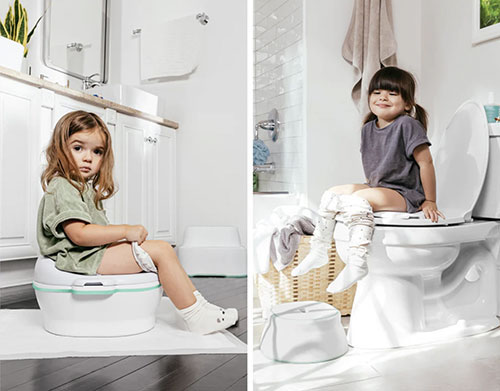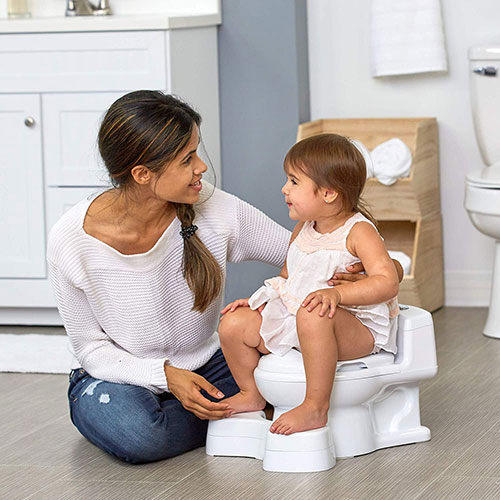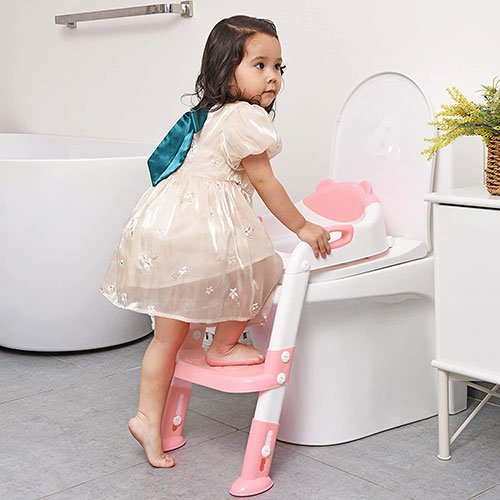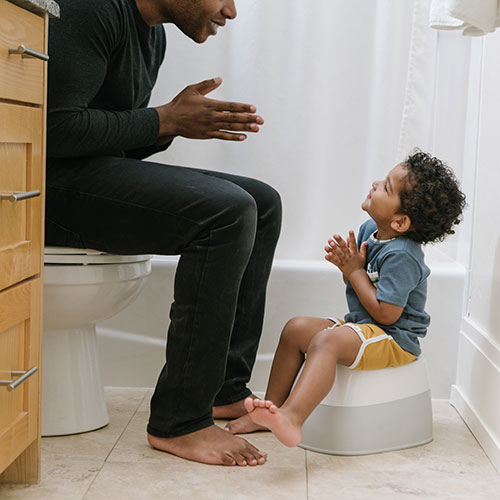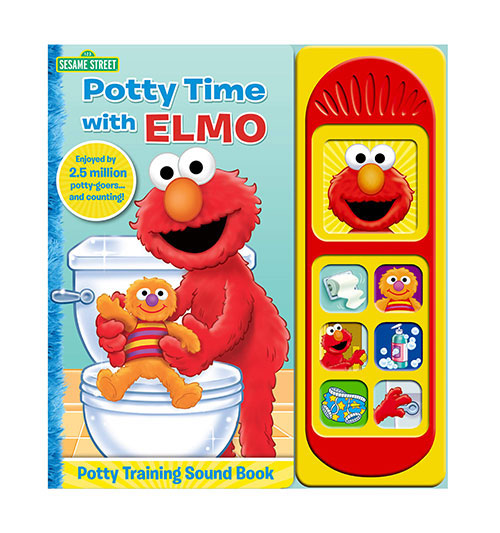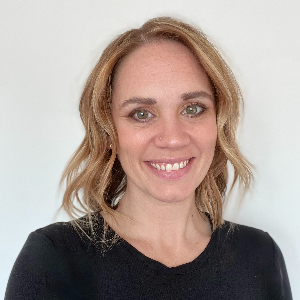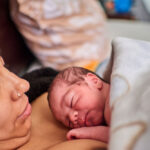Potty Training Your Toddler
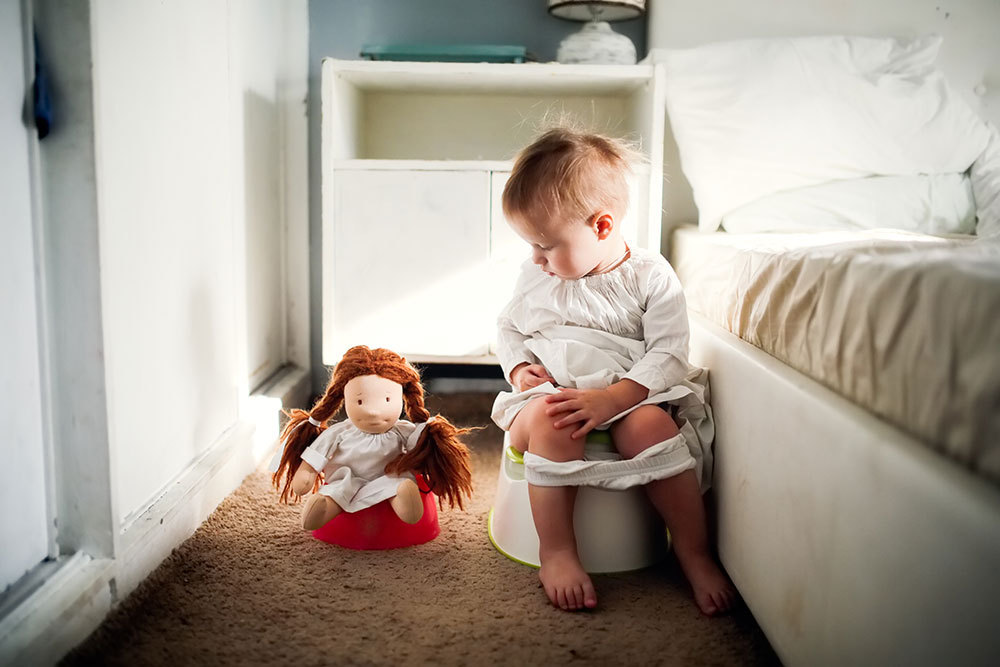
There’s no perfect formula for reaching this milestone but rest assured that you—and your tot—will get through it.
Medical Experts: Becky Kennedy, PhD; Tanner Walsh, MD, CLC, FAAP
Many things about the toddler years are hard on caregivers, from calming epic tantrums to trying to stay patient as they test boundaries to generally fearing for their safety as they explore the world around them. But if there is anything that can intimidate the heck out of someone raising a toddler, it’s the process of potty training.
Veteran parents are always full of suggestions when it comes to successfully getting through this milestone, but what works for one family might not work for another. Caregivers who take to social media to crowdsource advice from friends often end up with conflicting guidance, making them feel more stressed than they were in the first place.
While we at Pregnancy & Newborn have plenty of stories we could share about the pains (and hilarious joys) of potty training, we know that every child is different and we don’t want to add to your confusion and unease. Instead, we are leaving the advising to experts Stephanie Tanner Walsh, MD, CLC, FAAP, spokesperson for the Pennsylvania chapter of the American Academy of Pediatrics (AAP) and board member of the chapter’s Suspected Child Abuse and Neglect program, and Becky Kennedy, PhD, (more commonly known as Dr. Becky) clinical psychologist and founder of Good Inside.
What is the Average Age for a Child to be Potty Trained?
In the first few years of a child’s life, caregivers can usually tell if their child is on track developmentally because there is a standardized timeline for meeting milestones. We know, for instance, that by 4 months of age, most babies are beginning to make “ooh” and “ahh” sounds, and that by 9 months old, a baby can typically sit independently. Unfortunately, the timing of potty training isn’t nearly as easy to pinpoint.
“Potty training is about development,” says Dr. Walsh, “Each child develops at a different pace, so you can expect potty training to be the same.”
Dr. Becky says that many children may be ready to start using the potty “in the months around age 2,” and both she and Dr. Walsh emphasize that it’s less about a magic age and more about whether or not your child is showing signs of readiness.
“There are developmental signs that can help parents to know when their child is ready [to potty train],” says Dr. Walsh, such as mind-body readiness. “For example, noticing that they remained dry during naptime (this can start around 18 months of age).” However, she notes that tots also have to be able to decipher when their bladder is full, but this development “doesn’t usually click until around 2 years of age.” Other signs a toddler may be ready to start using the potty include hiding when they want to have a bowel movement or taking their diaper off immediately after a bowel movement.
As for how long the process might take, as with all things in child development, it depends on the individual toddler. “Some children can be potty trained in a few days and others may need months to years,” explains Dr. Walsh, “There will be many ups and downs with potty training, but eventually they will get there!”
What is the Best Method for Potty Training?
A quick Google search of this question will yield an alarming number of results. Some parents swear by hunkering down for three days for what can only be described as a “potty training boot camp.” Other caregivers may say their child was successful with incentives, like sticker charts and rewards systems. The “methods” are countless. But, if you ask Dr. Becky, the best approach is one that empowers the child.
“We [at Good Inside] don’t believe kids need training—in potty or anything else,” she says, “We stand by our Good Inside Potty Learning approach that feels good to you and your child. It’s based on empowering your child, not controlling or coercing them, as it leads not only to short-term potty success but also long-term confidence, body sovereignty, and independence.”
She further explains that she’s “not a big fan of rewards because they focus a child on external signals and pleasing others, which only leads them to be more disconnected from their internal signals—which is what potty success is all about!” Still, Dr. Becky acknowledges that for years, many of us parents have been sold on the idea that incentives and rewards are necessary potty training tools, but it doesn’t have to be that way. Good Inside’s model, based on empowering children, “builds up a child’s body awareness, internal motivation, and personal pride—which make rewards unnecessary.”
Again, every child is different, and there is no one-size-fits-all approach to potty training. That being said, whatever method you feel is clicking with your toddler, keep with it. According to Dr. Walsh, consistency is key here because potty training is tough on a kid, and suddenly switching up the rules on them will likely lead to confusion and possibly prolong the process.
Potty Training Tips
Both Dr. Walsh and Dr. Becky agree that helping a toddler find success using the potty can be a challenge and sometimes incredibly stressful for parents. But it’s important to keep your emotions under control during the process and to manage your expectations.
“The most common struggle (not “mistake”) I see is that parents’ desire for their child’s potty success leads them to operate from a place of control, which only gets in the way of the potty process,” says Dr. Becky.
Dr. Walsh encourages caregivers to go into the process remembering that “accidents happen—even in fully potty-trained kids,” so it’s important that you don’t expect perfection from your child. Additionally, she explains that sometimes a child will start the potty training process and it just won’t click for them, and in these cases, you may have to stop and try again at a later time when they may be a little more developed. Also, keep in mind that “stressful periods can impact potty training, such as the birth of a new sibling, a move, or a family crisis.”
Finally, if your child has a history of constipation or they are experiencing it during potty training as a result of withholding, talk to their pediatrician to ensure they stay healthy and safe (remember, as tired as you are of having to change dirty diapers, they are preferable to an impacted bowel).
Our Favorite Potty Training Products
If you’re at a point where you and your tot are ready to start the potty process, you’re going to want a training toilet, a stool, and a few other handy products. Here are some of our favorites to consider.
Frida Baby All-in-One Potty Kit
If you want to get everything you need in one quick and easy order, we suggest the Frida Baby All-in-One Potty Kit. It comes with a 3-in-1 Grow-With-Me Potty that starts as a training potty seat but converts to a toilet topper and step stool when your child is ready to move on to the big potty. The kit also comes with three leak-proof liners for the potty bowl as well as one disposable mess mat with an adhesive backing to help it stay in place and soak up accidents around the potty. Finally, caregivers will get in-depth advice from Dr. Becky with this kit because it comes with a potty-learning guide full of tips for toilet success. $60
The First Years Training Toilet with Stool
This training potty is unique in that it comes with a footrest. The First Years Super Pooper Plus Potty is designed to teach your tot proper posture when going potty. The footrest lifts the knees to a more natural position to make bowel movements easier with less pushing. Plus, when they’re done with their business, little ones can push the flush buttons that make realistic flushing and cheering sounds—because who wouldn’t want a little round of applause after a successful trip to the potty? $40
SKYROKU Potty Training Seat with Step Ladder
With a 4.5-star rating and more than 25,000 reviews on Amazon, the SKYROKU Potty Training Seat with Step Ladder is a favorite among caregivers of young children. It’s designed to fit most toilets and offers little ones a safe, sturdy way to climb up to the big potty and sit down on a seat that’s just their size. This training seat folds down easily when it’s not in use and it’s available in several fun colors (let your toddler pick their favorite to help them get excited). $40
The First Years Sit or Stand Potty
We like The First Years Sit or Stand Potty for its versatility. It can be set up on the floor like a traditional training potty, or you can mount it to your toilet to help your toddler learn how to use a urinal. It’s super easy to clean, offers adjustable height for the urinal option, and it has a non-skid base to keep the potty in place when your toddler is sitting on it. $16
Sesame Street: Potty Time With Elmo
If there’s anyone who can help a kiddo get excited about using the potty, it’s Elmo, right? Sesame Street: Potty Time With Elmo is an interactive board book that teaches children about going potty—complete with buttons that make fun sounds throughout the story. It’s an engaging way to start getting your child used to the idea of the potty or to keep them occupied while they’re sitting on the toilet. $8
Whether you’re in the midst of potty training now, or you know it won’t be long before you are, take heart in knowing that you will make it to the other side of this. It can feel really big and stressful, but it will be over before you know it. However, if you’re struggling to find an approach that works for your child, don’t be afraid to reach out to your pediatrician for some guidance that is tailored to your individual child.
Please note that some products listed are linked to affiliate websites and we may collect a small commission on your purchase.


